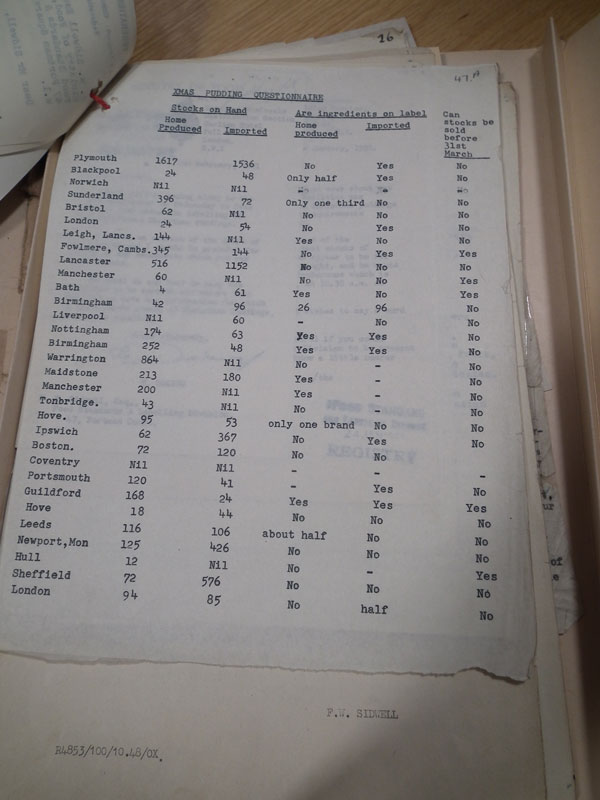With an array of different Christmas puddings now available, you probably didn’t have any problem getting hold of one this year. However, 60 years ago, you might have had a problem getting the ‘correct’ Christmas pudding, files in The National Archives reveal.

Making the Empire Christmas Pudding (catalogue reference CO 956/62)
The origins of the Christmas pudding can be traced back to medieval times but it wasn’t until the Victorian era that the Christmas pudding we know and love took on the recognisable form that continues to this day. But the debate about what makes a Christmas pudding continued into the 1940s and 50s, with committees and policy on Christmas Pudding Labelling (MAF 101/914) brought in after the war to ensure that Christmas puddings, also known as ‘The Empire Christmas Pudding’, did not go below the net weight of 17oz (with 1oz leeway) and contained the right ingredients (see image right):
Minimum oils and fats – not less than 9%
Sugar (added) – not less than 15%
Mixed dried vine fruits – not less than 40%
If Christmas puddings that had been imported did not have a label specifying the weight and ingredients listed by 31 March 1952, they could not be sold and could potentially result in prosecution, although it appears no-one was.
A Survey of Christmas puddings
Concern in 1952 about the licensing for making Christmas puddings, and the labelling to ensure ingredients were correctly listed, prompted a survey of Christmas puddings across the country. Plymouth was at the top of the Christmas pudding league table with 1,617 homemade Christmas puddings and 1,536 imported Christmas puddings, but they were all listed with ingredients. It was Lancaster in the ‘Christmas pudding spotlight’ with 1,152 unlabelled, imported Christmas puddings.
There was particular concern about Christmas puddings imported from other countries in the Empire without the correct labelling that were appearing across the country, sparking discussions between the Parliamentary Committee and the Ministry of Food.
It just goes to show that the proof is not only in the pudding; it must be clearly and correctly displayed on it as well.



What about plum puddings?
I plan to make this Christmas Pudding. In the past I have made a pudding from a recipe in an older Canadian recipe book.
Is there a breakdown for the pudding spice and what is a gill?
my mother used to make Christmas puddings 13 of them boiled them for hours in the old boiler in the outside wash house and added 2 or three bottles of stout to the mixture and we children would stir the mixture in an old welsh bread deep bowl on the floor.
What commotion over a pud, my Nanna was always 2 years ahead making the Christmas Pudding
How do I obtain the instructions on how to make the pudding?
I live on the other side of the ocean! 🙂
What is “the proof is in the pudding” supposed to mean?
The proof of the pudding is in the eating?
Speaking as a “pudding eater” the nicest ones are home made by my mother or daughter, but Fortnum and Mason’s are tasty.
We still make the recipe from my husband’s Methodist great-great Grandma ( a wiltshire family).
No alcohol and still dark, moist and delicious
I have just made Mary Berry’s and thought it not right as too many apple.. SO many a very olde recipe from Good Housekeeper. So let you know……….
Our Christmas puddings were, always, home-made – my mother cooking lots of them to give as gifts to many of the family. I don’t think we actually bought one until the 70’s.
This year, we are being careful and the family are meeting on line to eat our Christmas lunch. Mine will be produced and then delivered chilled by volunteers.
Of course, I shall be thankful in any case, but sample the pudding with renewed interest!
Evelyn Leroux
Gill…
Although its capacity has varied with time and location, in the United States it is defined as half a cup, or four U.S. fluid ounces, which equals 7.219 cubic inches, or 118.29 cubic cm; in Great Britain the gill is five British fluid ounces, which equals 8.669 cubic inches, one-fourth pint, or 142.07 cubic cm. (wikipedia)
I began making Christmas puddings following a recipe published by Guinness c. 1970. It is basically dried fruit, fresh breadcrumbs, spices and Guinness. It has never failed I have made them in London, Seoul and Beijing. I usually make 3 or 4 – keeping one for the following year. The third usually gets used at Easter. I took a couple to Pyongyang in 2001 and they were much appreciated by both Koreans and other Westerners.
My mom made a carrot pudding with brown sugar sauce. She steamed it and served it warm with the warm sauce and topped it with whipped cream. MMM MMM good.